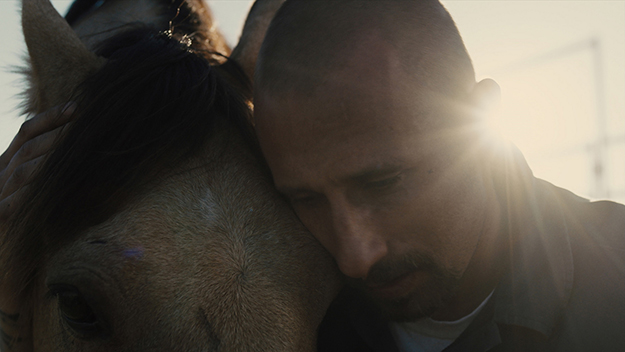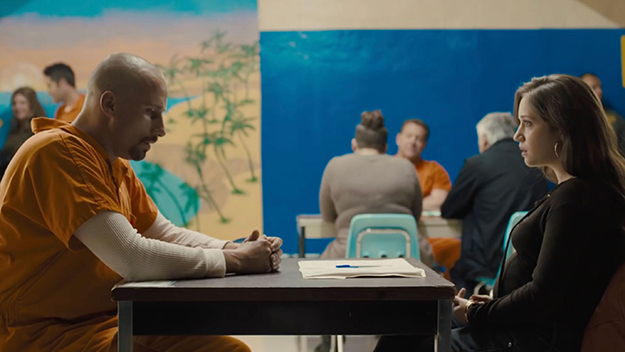Laure de Clermont-Tonnerre’s first feature The Mustang opens with exhilarating, heartbreaking images of a helicopter rousing mustangs from their lordly nuzzlings and slumbers to race across a Utah plain and get herded into vans. Few films capture the wildness of feral horses so bluntly: they embody a vaulting kind of freedom and respond with confusion and fury when corralled. That’s a lot to get from a fictional movie these days. The Mustang gives us more good stuff—touching and hair-raising vignettes of equine and human power—when it takes us inside the Wild Horse Inmate Program (WHIP). At prisons in a half-dozen Western states, like the Northern Nevada Correctional Institute in this film, prisoners learn to transcend their own impulsiveness and volatility in order to manage these flesh-and-blood emblems of independence and free will. They train the horses so they can be auctioned off to farmers, ranchers, or the Border Patrol, with proceeds going to WHIP. The program helps restrict the growth of a mustang population estimated at 100,000, roughly four times the number that the Bureau of Land Management says can be sustained on today’s rangelands. The main action kicks in when WHIP program director Myles (Bruce Dern) senses that a hulking, violent convict with the unlikely name of Roman Coleman, who exudes raw power and “don’t touch me” vibes, could be just the man to tame a proud beauty that the con dubs “Marquis.” The plot is simple. Outside, Roman and Marquis test each other to near breaking point; inside, Roman navigates a prison that’s new and strange to him and to us. The movie offers an uneven slice of life, cut with a shiv. We experience the awful ordinariness of serving hard time but we never get a structured vision of what it means to live locked up. The lessons Roman learns in the pens and corrals are not dramatically analogous to the traumas he experiences in the cellblock and recreation yard. But they do enable Roman to examine and bolster his character. We meet him right after he’s been moved from a facility where he was held in solitary confinement. The prison psychologist (Connie Britton) employs a multiple-choice questionnaire to gauge his anger-management score as he enters the prison population. Roman refuses to answer, smacking the panic button on her desk to halt the meeting. His wrath is off the charts. An unstressed strain of mordant humor threads in and out of the narrative from the moment Roman confesses, “I’m not good with people.” She assigns him to “outdoor maintenance” so he can be on his own. A veteran maintenance man tells Roman to clean up the horses’ mess. When Roman asks if he’s the boss, the fellow says, sardonically, “Yeah, I’m the chief of shoveling shit.” The film is rough around the edges—and, sadly, at the core. It doesn’t delve as deeply as we hope into jailhouse alienation or integrate the horse tale into a lucid and compelling cross section of prison life. But it’s also porous in a good way: nuances and complexities seep in. The sounds of hooves pounding against the walls of a shuttered pen draws Roman to this horse the way thumping drums attract explorers in jungle movies. It’s what he sees, though, not what he hears, that cements their bond—the inexhaustible energy in Marquis’s body and the bottomless vitality in his eyes. When Myles sizes up Roman and comprehends his fascination with the mustang, then invites him to try out as a handler, the program becomes the seedbed for his transformation. Roman’s engrained caveman reflexes nearly scuttle his chances for redemption: he can’t abide the mustang’s resistance. In the most shocking and original scene, he actually slugs the horse, repeatedly. At his nadir he realizes that the horse is his mirror image, down to the animal’s ability to take a punch.
In Britton’s second big scene, she asks a therapy group, including Roman, to compare the seconds or minutes it took to decide whether to commit a violent crime with the years spent behind bars paying for it. The back-and-forth makes for a devastating exercise, but it comes out of nowhere in the movie, so it registers like a miracle cure for anger addicts. When Roman gets tossed into solitary for that horrifying act of cruelty toward Marquis, he becomes part of an inter-cell smuggling system that delivers items as outré as equestrian magazines. We have to wonder, “How does that work?” De Clermont-Tonnerre sketches the waking nightmare of living in close quarters without laying out a single “normal” day from dawn to dusk. The scenes set in the visiting room, where Roman’s daughter Martha (Gideon Adlon) makes some justifiable demands on him, are stagey. Happily, though, de Clermont-Tonnerre (who also wrote the script with Mona Fastvold and Brock Norman Brock) possesses a healthy aptitude for animal ferocity and grandeur. Cinematographer Ruben Impens’s camera puts us by Roman’s side, whether in the cramped cell he shares with a Dorito-chomping, Ketamine-snorting low life, a not-so-dapper Dan (Josh Stewart), or in a corral surrounded by supportive fellow inmate-handlers. Impens and the director use wider shots for striking visual contrasts, not for context. De Clermont-Tonnerre’s outside-in approach doesn’t always provide sufficient clarity on the action. Her screenplay introduces racial rifts and Ketamine-smuggling gangs without rendering their tensions or signaling the seriousness of their threats. Yet her tunnel vision does pay off in unexpected ways. Calmly and dispassionately she observes an inmate getting shivved in a prison yard. Rather than immediately haul his body off on a stretcher, the guards maintain order by keeping the rest of the prisoners face down on the concrete. The victim bleeds out before the arrival of the medics. It’s a quietly harrowing moment of truth. The Mustang almost always looks limber and alive, partly because de Clermont-Tonnerre is no slave to reality. Strictly for color, for instance, her inmates wear orange jumpsuits all year round (not just for processing), changing to blue jeans and grunge-wear only when they tend the horses. Seeing them roughhouse and scramble in the shadows of the Rockies, they appear to occupy a world apart. The film generally balances its upbeats and downbeats. Under the guidance of a talented handler, Henry Davis (Jason Mitchell), Roman grows to understand the importance of patience in horse training and in life. Alertness takes the place of gut reactions as he relaxes into all his instincts, rather than rely merely on fight or flight. None of the actors sentimentalizes his or her roles. Britton’s Big House shrink combines competence, convention, and a few sparks of intuition, like a decent social worker in a Mike Leigh film, and Dern fills out the program director with gravelly wisdom and a few masterstrokes of magician-like misdirection. Mitchell’s Henry, though, is the one who makes the drama swing: most of the time, when he’s in the picture, we could even call it a comedy-drama. An exuberant actor playing a surprisingly delighted man: it’s a perfect match. Henry wants to prove to Roman that to communicate with a horse, he’s got to dance. Mitchell’s own loose yet forceful physicality cinches the case for him.
The writer-director’s antennae must have been tingling when she cast Matthias Schoenaerts as her antihero Roman and set up her production at the abandoned Nevada State Prison, a brutally utilitarian edifice (a short distance from the actual Northern Nevada Correctional Institute). That man and this place seem made for each other, optically and existentially. Schoenaerts carries the movie on his formidable shoulders: he acts with everything he has, including his physique. He moves powerfully and often clumsily, as if he’s muscle-bound. Furious self-hatred binds him up; what lies beneath are remnants of feeling. We track Roman’s healing by his attempts to communicate with his pregnant 16-year-old daughter Martha (Gideon Adlon) in a series of sit-downs in a shared visiting room. She wants him to sign emancipation papers so she can sell her grandma’s house and move away; he progresses from shutting her down to bearing his soul. The mechanics of these scenes are rudimentary, functioning as a psychological striptease. They peel away one level of Roman’s defenses after another, so we learn the nature of his crime and the basis of Martha’s resentment only after he redeems himself in our eyes with Marquis. Yet Schoenaerts and Adlon give these trumped-up father-daughter sessions genuine crosscurrents of emotion. Much like Marquis, Adlon puts a challenge in her eyes that Roman fortifies himself to meet. De Clermont-Tonnerre’s directorial hunches outstrip her merits as a writer. She makes wonderful use of a prison photographer (Sean Patrick Bridges) who poses inmates and their guests against picturesque cartoon backdrops and prods Schoenaerts into a pained, minimalist smile. Schoenaerts’s true co-star, though, is a composite animal. De Clermont-Tonnerre combines two Andalusian horses and one mustang, with buckskin coats and brown-black manes and forelocks, to create Marquis. We share Roman’s crush on the horse and his wonder at Marquis’s rock-hard defiance. The setup doesn’t permit the inventive magic of The Black Stallion’s getting-to-know-you scenes between the boy and “the Black,” but Schoenaerts’s passion and Marquis’s grace make their dance-of-life-or-death indelible. Exhausted and facing defeat, Roman has just about given up on “gentling” the mustang when the haughty Marquis signals readiness. The horse’s head dips into the frame next to the man’s in a motion that’s clean and tender, maybe even compassionate. It’s an equine benediction. Michael Sragow is a contributing editor to Film Comment and writes its Deep Focus column. He is a member of the National Society of Film Critics and the Los Angeles Film Critics Association.


